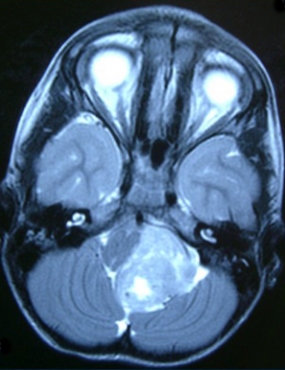Brain Tumors Found to Have a Two-Tier System
Scientists of the German Cancer Research Center (Deutsches Krebsforschungszentrum, DKFZ) and Heidelberg University Hospitals have led the largest ever molecular-biological analysis of ependymoma, a dangerous brain tumor in children. They were able to define two distinct subgroups of ependymoma which differ both genetically and clinically. The researchers will now use these results to gain a better understanding of the causes of ependymoma and to develop more targeted treatment approaches.
Ependymomas are the second most frequent type of malignant brain tumor in children. Ependymoma develops from precursor cells of the tissue that lines the hollow cavities of the brain. Therapy results of ependymoma vary immensely: While in some patients tumor growth comes to a standstill after surgery and radiotherapy, in other children the disease rapidly takes a severe course. In about half of those affected the tumor continues to grow and the patients often succumb to the disease.
„It is the patients with a severe course, in particular, who urgently need better therapies. To this end, we need to understand what makes ependymomas so different in their characteristics,“ says pediatrician and molecular geneticist Dr. Stefan Pfister, who is a researcher at DKFZ and Heidelberg University Hospitals. Jointly with his colleague, Dr. Hendrik Witt, Pfister and researchers from Canada, the U.S.A., Russia, Poland and Italy are now publishing the results of the largest ever molecular-genetic study of ependymomas of the cerebellum. This is where this type of tumor is most frequently located in children, while in adults ependymoma usually arises in the cerebrum or in the spinal cord.
In 583 tissue samples of ependymomas of the cerebellum, the investigators studied the activity of individual genes and searched the genetic material for losses or gains of whole DNA segments. Two groups of these tumors were first analyzed independently and the results obtained were subsequently validated based on the tissue samples of a third group. In this way, the investigators obtained particularly valuable results.
The large-scale study has yielded clear results: Based on anomalies of their genetic material, ependymomas of the cerebellum can be classified in two distinct subgroups which also differ clinically. Group A ependymomas take an unfavorable course; such tumors often recur after initial surgery and they frequently metastasize, which ultimately leads to the death of many patients. Group A tumors have relatively few losses or gains of gene segments; however, very many genes that play a role in key cancer signaling pathways are activated.
By contrast, tumors of group B have a favorable prognosis, even though the genome of these cancer cells is highly unstable. Typical characteristics are gains of large segments of chromosomes 9, 15, 18 as well as losses of chromosomes 6 and 22.
“The genetic differences between these two types are so marked that we have to speak of two different diseases that may even arise from different original cells,” says Stefan Pfister. The Heidelberg researchers will now take a closer look, in particular, at group A ependymomas in order to find out which of the genetic alterations is what is called the driver mutation, i.e. the mutation that causes carcinogenesis. In this way, they hope to identify potential targets for better drugs to specifically fight the more aggressive group A ependymomas. For several signaling pathways that are hyperactive in group A tumors, targeted drugs have already been developed and are currently being tested for other types of cancer in clinical trials. It is possible that some of these substances may be a treatment option for ependymoma as well.
But patients will also benefit from the results of the genome analysis in the near future: Using simple tests, doctors will be able to assign a case to one of the two subgroups and they will thus be in a better position to decide how intensive treatment must be.
Hendrik Witt, Stephen C. Mack, Marina Ryzhova, Sebastian Bender, Martin Sill, Ruth Isserli, Axel Benner, Thomas Hielscher, Till Milde , Marc Remke, David T. W. Jones, Paul A. Northcott, Livia Garzia, Kelsey C. Bertrand, Andrea Wittmann, Yuan Yao, Stephen S. Roberts, Luca Massimi, Tim Van Meter, William A. Weiss, Nalin Gupta, Wiesia Grajkowska, Boleslaw Lach, Yoon-Jae Cho, Andreas von Deimling, Andreas E. Kulozik, Olaf Witt, Gary D. Bader, Cynthia E. Hawkins, Uri Tabori, Abhijit Guha, James T. Rutka, Peter Lichter, Andrey Korshunov, Michael D. Taylor and Stefan M. Pfister: Delineation of Two Clinically and Molecularly Distinct Subgroups of Posterior Fossa Ependymoma. Cancer Cell, 15 August 2011
With more than 3,000 employees, the German Cancer Research Center (Deutsches Krebsforschungszentrum, DKFZ) is Germany’s largest biomedical research institute. DKFZ scientists identify cancer risk factors, investigate how cancer progresses and develop new cancer prevention strategies. They are also developing new methods to diagnose tumors more precisely and treat cancer patients more successfully. The DKFZ's Cancer Information Service (KID) provides patients, interested citizens and experts with individual answers to questions relating to cancer.
To transfer promising approaches from cancer research to the clinic and thus improve the prognosis of cancer patients, the DKFZ cooperates with excellent research institutions and university hospitals throughout Germany:
The DKFZ is 90 percent financed by the Federal Ministry of Education and Research and 10 percent by the state of Baden-Württemberg. The DKFZ is a member of the Helmholtz Association of German Research Centers.


